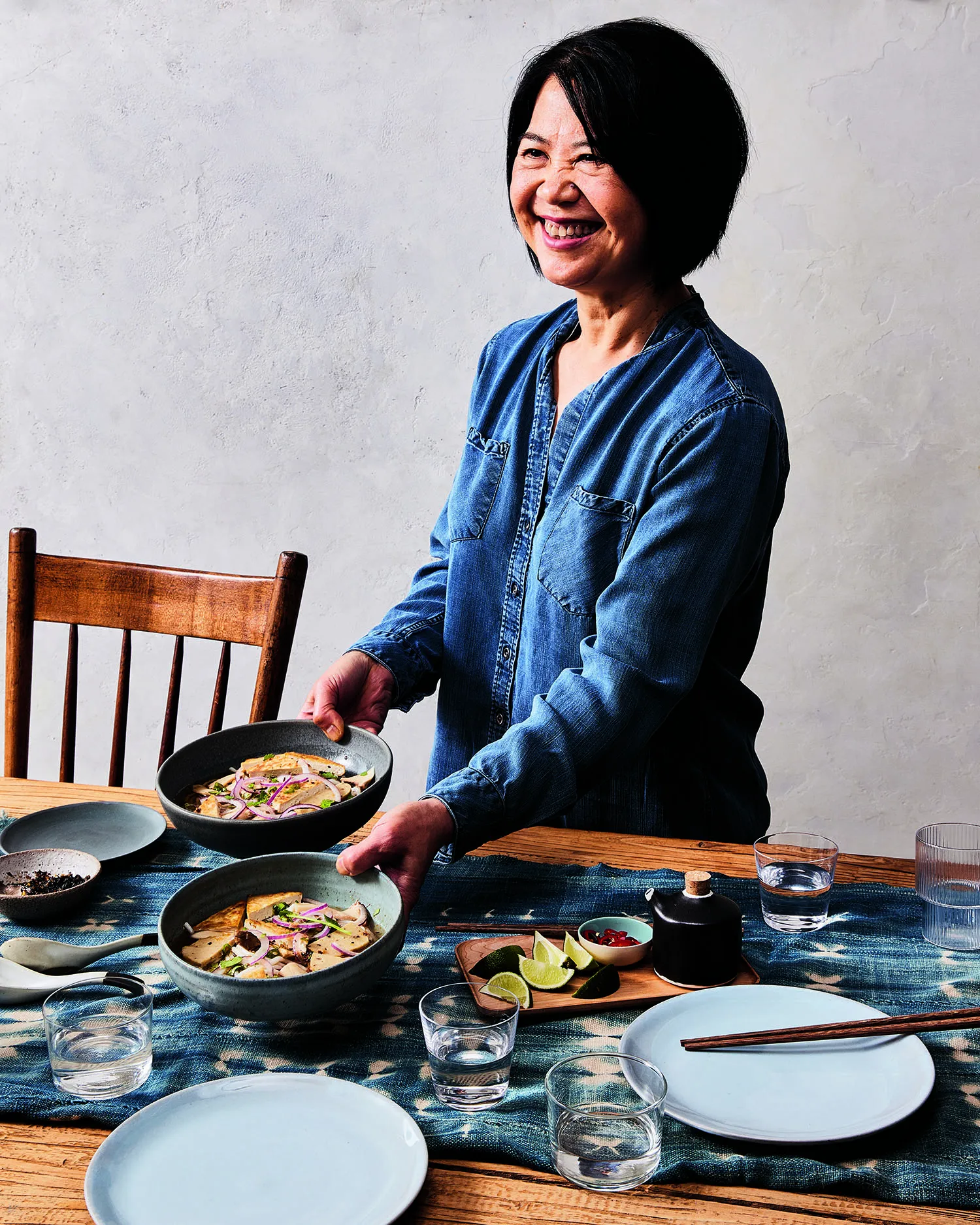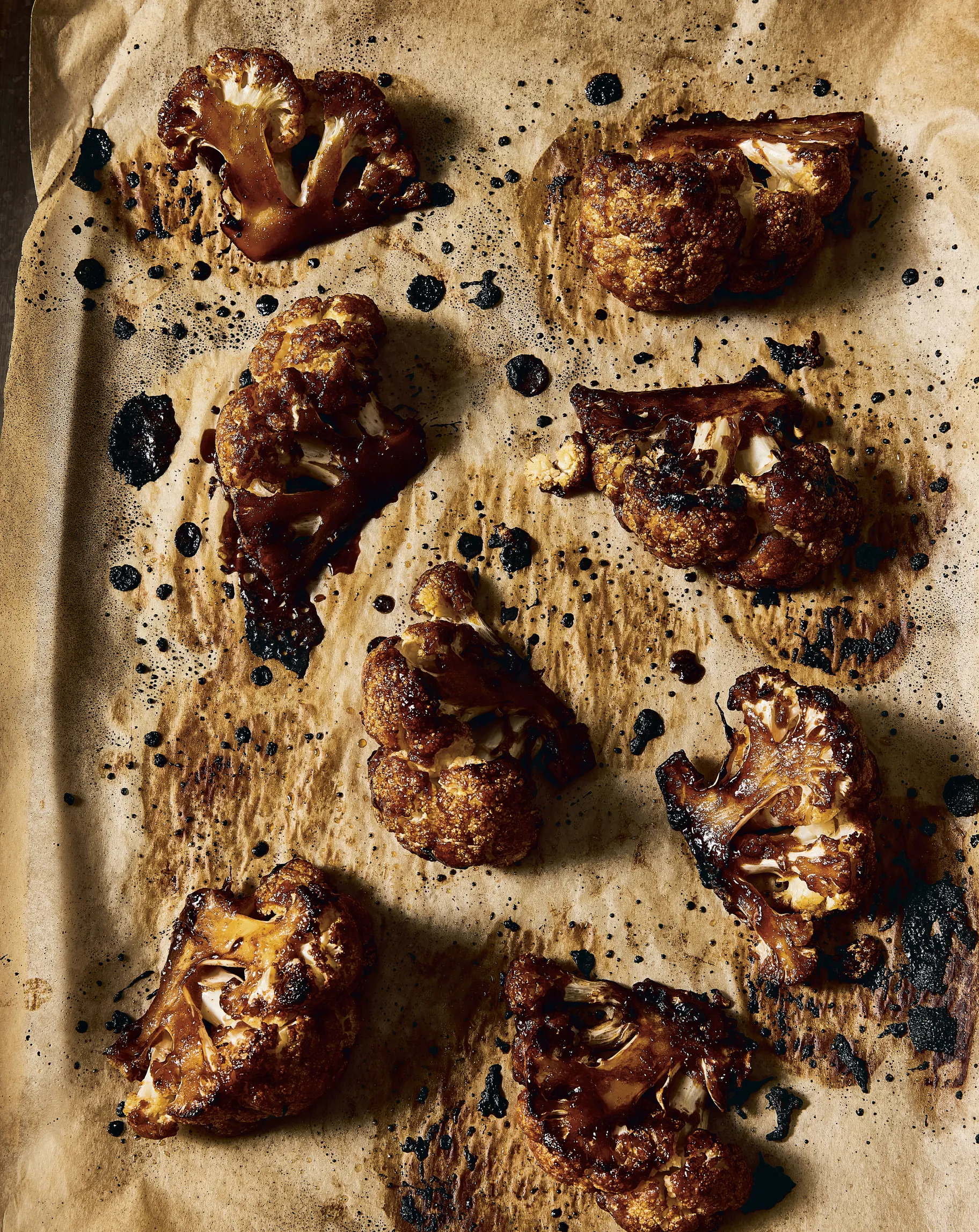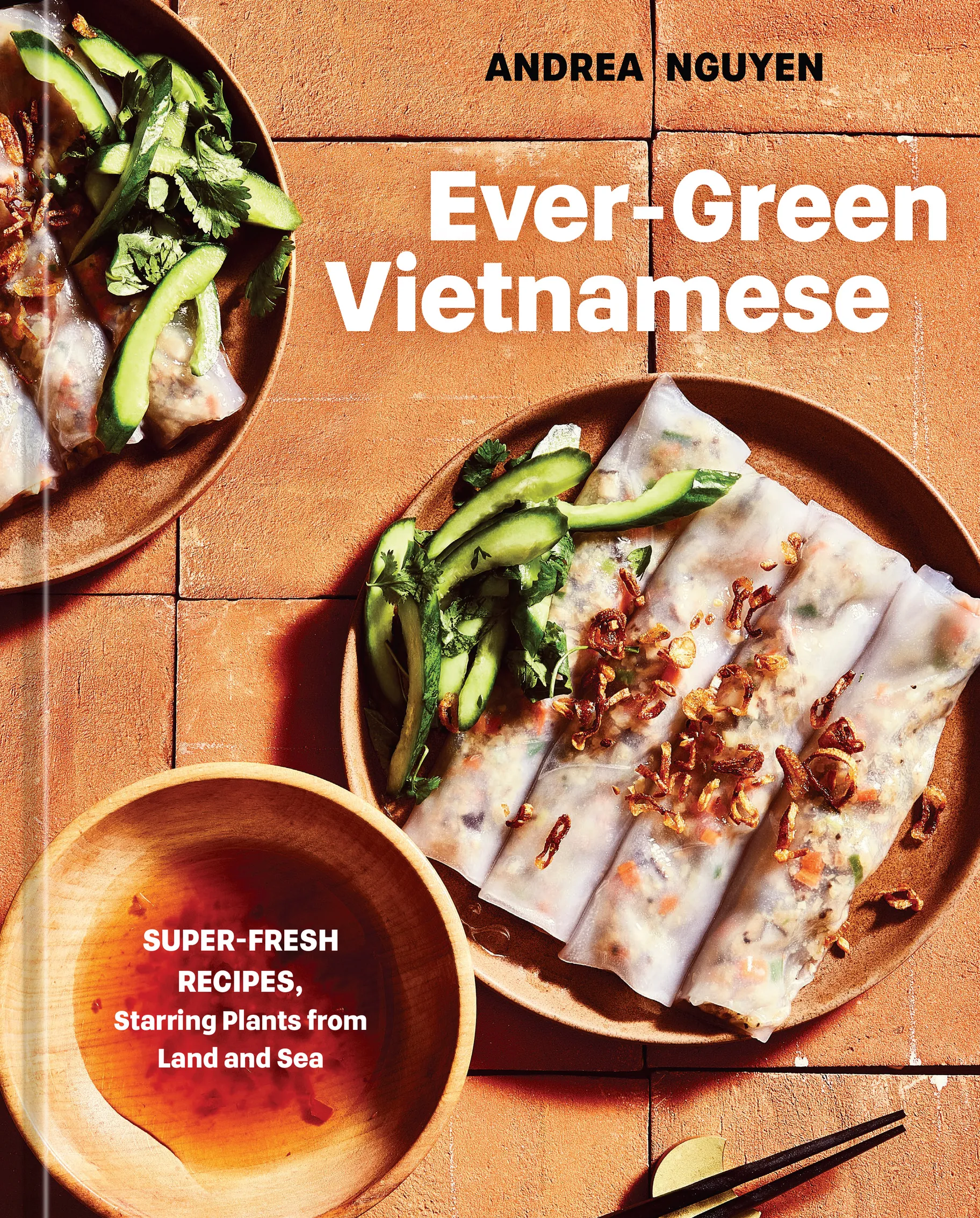You can count Good Food among the legions of Andrea Nguyen fans. A prolific cookbook writer and teacher, she's known for her no-nonsense approach and enticing recipes that work. Her sense of humor and deep knowledge of her subject are what centers her website, Viet World Kitchen.
Nguyen's latest cookbook is “Ever-Green Vietnamese: Super Fresh Recipes,” which takes a plant-focused look at the food of her home country.
KCRW: This is an interesting pot for you to stir. Why "Ever-Green"? Why now? And does that mean no animal proteins at all?
Andrea Nguyen: No animal protein is not how I eat and cook. "Ever-Green" is about my approach to sustainable health, for my own well-being and for the planet. The evergreen part is about enduring ideas in the Vietnamese kitchen, and that is the notion of centering plants on the plate or in your rice bowl.
When you started to approach collecting recipes for the book, did you look for traditional ones that happened to be plant-based? Or did you take traditional ones and evolve them?
I'm taking door number two. When I started this project, my publisher was like, "We can sell a Vietnamese vegetarian cookbook." I said, "That's great, but I can't write that book because I'm not a vegetarian." But I understand the needs of vegetarian cooks.
One of the questions that's always been presented to me is: “What the heck are you going to do about fish sauce?” When I started on this project, I thought to myself, I need to figure out a way to get around the elephant in the kitchen, so to speak, which is a bottle of fish sauce. So I came up with a vegan fish sauce recipe that I reverse-engineered from very good vegan fish sauce that comes out of Vietnam.

Cookbook author and teacher Andrea Nguyen developed a vegan fish sauce using seaweed and pineapple juice. Photo by Aubrie Pick.
There must be some industrial fish sauce products out there that are created for the vegan market. Why did you go to the trouble of creating a vegan fish sauce recipe yourself?
There are. The ones that I've tried that come from mainstream markets are so bland and off the mark. And they're expensive. The ones that are available at Vietnamese markets, they're good but they're hard to find for people, and they have certain additives that I don't care for. So I thought to myself, "Can I use ingredients that are pretty much at my disposal to come up with a vegan fish sauce that's a one-to-one swap with regular fish sauce?" And holy smokes, I did.
What are some of the major players in the recipe? Is it a fermented product?
No, it's not fermented. The foundation is seaweed and pineapple juice. It's remarkable because once you go through the motions of making vegan fish sauce, you go, "Oh, wow." Canned pineapple juice has this kind of fermented tang. And once you combine it with seaweed, it presents itself as a briny fermented sauce from the sea, almost like a sea sauce. The salinity comes from salt, a flavor enhancer.
There are so many condiments in your book — not only condiments that we add after the dish is done, but condiments that are used in the cooking itself, like scallion oil. It's the greatest all-purpose condiment. Talk about your recipe for garlicky green onion sizzle that it’s used in.
You gotta have sexy names to catch readers. There's a lot of scallion oil, or green onion oil. We call it in Vietnamese "honma" or "mohan," which refers to fatty green onions, because it's typically made with lard but oil works fine. You would heat up oil and throw a bunch of green onions in there, but I add garlic to it too, as well as some fish sauce. I will add a pinch of baking soda just to hold the green color, and there is chili in there as well. It's a sauce that I keep around. In the book I put it on grilled eggplant.
It's a great summer thing. Once you start cooking with a lot of vegetables, you pay attention to their personalities in ways that you don't otherwise. When I started grilling six slabs of eggplant and eating it on its own with that scallion garlic sizzle, I had this thing of like, oh gosh, eggplant can cook up to this super rich lusciousness, almost like the fat in pork belly.
Vegetarians may not always use descriptors like that for vegetables, but I'm an omnivore. So I looked at that eggplant and I'm like, you know, it reminds me of that. Or a king trumpet mushroom is kind of like the firmness and texture of chicken thighs or chicken drumsticks. It becomes really fun for me as a cook, and I think it's a great way for people to plug into using vegetables in the kitchen without making it seem like it's this strict, arduous thing that you have to be religious about.

Cutting cauliflower into wedges reduces waste for this roasted char siu dish. Photo by Aubrie Pick.
Cauliflower is another great example of that. Tell us about the char siu roasted version that you have.
People have roasted cauliflower in all different ways, but why haven't there been many cauliflowers done char siu style? Then I was like, "I'll do it." It's such a simple recipe, but one of the things I wanted to do with that is to prep the cauliflower in a way where there's minimal waste. I cut them into wedges so you're not just cutting steaks, and then the recipe says, "Just save the other parts for other recipes." My thought was, "What are those other recipes?"
So I cut them into wedges, then the wedges are roasted in this very simple char siu seasoning sauce. The cauliflower releases all of this liquid and it concentrates, it cooks down in the hot oven. I have people swipe the cauliflower through the seasoning sauce as it's concentrating and it sticks to the char siu. Typically with char siu, you're basting the meat with the marinade or the seasoning sauce throughout the cooking process. I didn't want to do that. I was looking at this liquid and I thought to myself, "Just let it cook and it evaporates and kind of does the work for you." So it's very similar and it comes out having this chewy, meaty quality. It's so much fun to make.
It sounds really fun. So let's talk about what your husband calls “The Cake.”
He calls it “The Cake.” My mom just calls it “Vietnamese Coffee Cake.” It's a mocha cake. I started out thinking, "It'd be so great to make Vietnamese coffee cake, but not coffee cake in the traditional American way."

"Ever-Green Vietnamese" brings plants to the center of the rice bowl. Photo courtesy of Ten Speed Press.
A cake that was Vietnamese coffee in solid form.
Right. I thought, "It'd be so great, so easy." But it turns out that when you bake a cake with condensed milk, like a regular layer cake, it's not so easy. I went at least 30 rounds before I got it right. And we were in the middle of a kitchen remodel, so the guys would come around 8:30 or 9 a.m., but I would wake up early in the morning before they got to my house.
I would plug the stove back in because they had it on wheels and I would bake a test trial of the cake. If it worked out, someone on the construction crew would get cake. My neighbors got cake, too. It is a cake that tastes like Vietnamese coffee, and it's absolutely delicious. That's something that my neighbors and my mother continually ate with no complaints.
The downside to doing this job is if one doesn't eat before, one gets very hungry.
It is the problem when we talk about food and work in food. It is so enticing.
This whole book is just gorgeous. The whole thing is enticing.
Thank you. I worked on it with a legendary editor named Lorena Jones, whom I've known since I started my career in food writing. She recently retired after 30 years in the industry and this was the last book that she edited. We wanted to make a book that was substantive.
This is the only vegetarian Vietnamese book that I'll ever write. It's a vegetarian or vegetable-centric book that's for everyone. We talk about healthy eating, and oftentimes it is centered on the Mediterranean diet, which I absolutely love, but there are a lot of really healthy, fun things that you can do with Asian cuisines as well. So that's the promise behind "Ever-Green Vietnamese," and I hope it delivers.
Vietnamese Mocha Cake
Bánh Moka
Makes 8 servings
Ingredients
- 2 Tbsp instant espresso, or 21⁄2 Tbsp instant dark-roast coffee granules
- 1 1⁄2 Tbsp unsweetened cocoa powder (see Note)
- Scant 2⁄3 cup sweetened condensed milk (coconut, if preferred)
- 2 Tbsp neutral oil (such as canola or peanut)
- 6 Tbsp unsalted butter or virgin coconut oil, cut or spooned as 5 or 6 chunks
- 1 1⁄4 to 11⁄2 tsp vanilla extract
- 1 cup all-purpose flour (bleached or unbleached)
- 1⁄2 tsp baking powder 1⁄4 tsp baking soda
- 1⁄4 tsp fine sea salt
- 2⁄3 cup granulated sugar 2 large eggs, at room temperature
- 1⁄3 cup heavy cream, at room temperature
COFFEE-FLAVORED WHIPPED CREAM
- 2 Tbsp sweetened condensed milk (coconut, if preferred)
- 1⁄4 tsp plus 1⁄8 tsp vanilla extract
- 2 tsp instant espresso, or 21⁄2 tsp instant dark-roast coffee granules
- 2⁄3 cup heavy cream, cold
- 2 Tbsp full-fat sour cream or Greek-style yogurt (dairy- free, if preferred; optional, for extra body and sheen)
Instructions
Cook the mocha base
1. In a 1- to 1 1⁄2-qt saucepan, combine the instant espresso, cocoa powder, condensed milk, neutral oil, and butter. Set over medium-low heat for 2 to 3 minutes, stirring constantly, until the mixture resembles soft pudding (the coffee may not fully dissolve). Set aside for about 15 minutes, until lukewarm or room temperature (it will thicken). Stir in the vanilla for a caramel-ish finish.
2. Meanwhile, position a rack in the lower third of the oven. Set a pizza stone or a baking sheet on the rack to regulate the heat so the center of the cake doesn’t sink as it cools. Preheat the oven to 350°F. Lightly oil the bottom and sides of an 8-inch square or 9-inch round baking pan (with at least 2-inch-high sides) and line the bottom with parchment paper.
Make the batter and bake
3. In a medium bowl, combine the flour, baking powder, baking soda, and salt. Beat with a fork about 20 seconds to combine well.
4. In a large bowl, combine the sugar and eggs and whisk vigorously for 1 minute, or until smooth, slightly frothy, and creamy yellow. Scrape in the mocha base and whisk to combine. Using the whisk, gently stir in the flour mixture and the cream in this alternating manner: one-third of the flour mixture, half of the cream, another third of the flour mixture, the remaining cream, and then the last third of the flour mixture. Between additions, you shouldn’t see a trace of the ingredient just added. Scrape the batter into the prepared pan, shimmy it to level the top, and then hold the pan 2 to 3 inches above your work surface and drop it to remove large air bubbles.
5. Bake the cake for 28 to 40 minutes, or until it is dry on top, springs back lightly when touched, and a toothpick or skewer inserted in the center comes out clean but feels slightly moist. Observe and be patient. When done, the cake ideally should not have pulled away from the pan sides. Let cool completely on a wire rack, about 45 minutes.
Prepare the whipped cream
6. If it’s warm in your kitchen, chill a small or medium metal bowl.
7. To make the Coffee-Flavored Whipped Cream: In the metal bowl, combine the condensed milk, vanilla, and espresso and stir to dissolve the coffee (it’s okay if some doesn’t dissolve). Pour in the cream and then use an electric mixer on low to medium speed to whip it until it holds soft peaks (pause to lift the beaters and the clinging creamy tips slump over). Add the sour cream (if using), then continue beating to a voluptuous texture that holds its shape. Cover and keep chilled.
Assemble and serve
8. Run a knife around the sides of the cake. Put a cooling rack over the pan and invert, then remove the pan and paper. Place a serving plate over the cake and invert again so it is right-side up. Cut pieces of cake and, using two spoons, scoop whipped cream on top of or alongside the pieces to serve.
Reprinted with permission from "Ever-Green Vietnamese: Super-Fresh Recipes, Starring Plants from Land and Sea" by Andrea Nguyen, copyright © 2023. Published by Ten Speed Press, an imprint of Penguin Random House.
Char Siu Roasted Cauliflower
Bông Cải Trắng Nướng Vị Xá Xíu
Serves 4
Ingredients
- 2-lb head cauliflower 3 Tbsp hoisin sauce
- 2 Tbsp toasted sesame oil
- 1 Tbsp agave syrup or mild honey
- Scant 1 Tbsp ketchup 11⁄2 tsp soy sauce
- 2 garlic cloves, minced and mashed or put through a garlic press
- 1⁄4 tsp Chinese five-spice powder
Instructions
Cut the cauliflower
1. Position a rack in the middle of the oven and preheat to 450°F. Line a rimmed baking sheet with parchment paper.
2. Pull off or cut away large leaves from the cauliflower, saving them for soup or broth, if you like. Trim a slice from the core end, where it’s likely discolored. While holding the cauliflower at a comfortable angle, curved-side down, insert your knife tip into the core. As you push the knife in farther, gently rock the blade side to side and back and forth. In a few seconds, the cauliflower head should crack and naturally break into two halves (mine are always uneven).
3. Now, cut each half into four wedges, each no thicker than 3 inches on the uneven floret side. (Hold the cauliflower flat-side or curved-side down, whichever is more comfortable. Cut an additional wedge only if you must.) Using a dish towel, dry the wedges so they’ll absorb the seasonings well.
Season and roast
4. In a big bowl, stir together the hoisin sauce, sesame oil, agave syrup, ketchup, soy sauce, garlic, and five-spice powder. Add the cauliflower wedges and, using a big spoon or spatula, stir to coat well. Most of the seasonings should adhere. Spread the wedges out onto the prepared baking sheet, cut-side down. Drizzle or smear any remaining seasoning from the bowl onto the wedges.
5. Roast the cauliflower for 15 minutes, use tongs to turn over the wedges, and then roast for 10 minutes longer. Liquid will appear on the pan. Continue roasting for 10 to 15 minutes, during which the liquid will concentrate, bubble, and thicken. As that happens, use the tongs or a spatula to flip the cauliflower pieces about three times so they pick up the seasonings. When done, the cauliflower should look richly browned and be tender yet slightly chewy. A knife tip pierced into the thickest core areas usually meets a little resistance. The total roasting time is about 40 minutes.
6. To get a slightly deeper color and flavor, keep the baking sheet in its place and switch on the broiler for about 60 seconds, monitoring carefully to avoid burning. Remove the cauliflower from the oven and let it rest a few minutes to develop flavor before serving.
Reprinted with permission from "Ever-Green Vietnamese: Super-Fresh Recipes, Starring Plants from Land and Sea" by Andrea Nguyen, copyright © 2023. Published by Ten Speed Press, an imprint of Penguin Random House.
